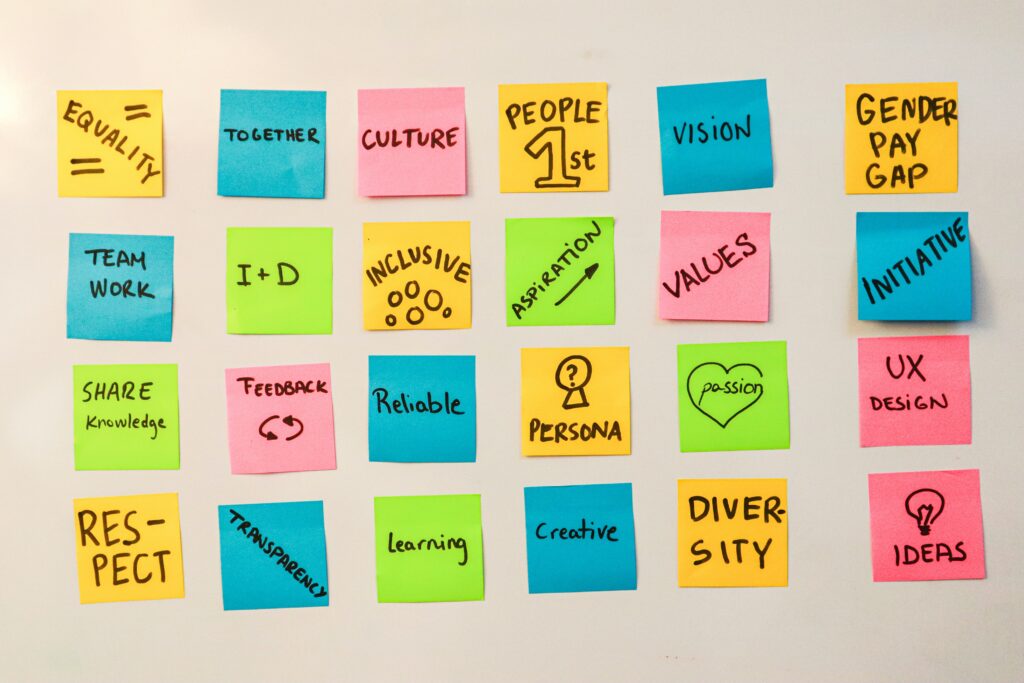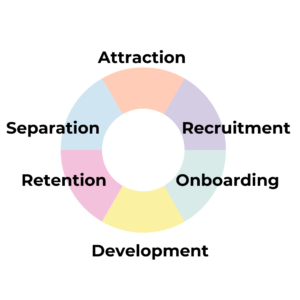
When do organisational values matter during the employee lifecycle?
Of course, it’s an obvious trick question.
Values matter throughout the entire lifecycle, from someone first being attracted to apply for a role, through to them exiting after a successful and happy period of employment. Clear and well-embedded organisational values set the direction for the organisation. They steer the culture and provide a framework for the behaviours expected within the company.
But, in reality, it doesn’t always work like that. If the organisational values aren’t an integral part of ‘what we do and how we do it’, they become woolly and less effective over time, their impact fading away.
In our culture reviews with clients, we like to examine the existing culture with various lenses: from top to bottom, inside-out and outside-in, and across functional areas and customer journeys. But we also like to turn an eye to how the culture presents across the stages of the employee experience.
So, how can organisational values be baked into the employee lifecycle for maximum effect?
The employee lifecycle includes the following core steps:
- Attraction
- Recruitment
- Onboarding
- Development
- Retention
- Separation
Let’s take a look at how your organisational values might come to life in each of these stages, and a few ‘bear traps’ to avoid.
Before we do, it’s important to note that this isn’t just about making sure your values are clear and understood at each stage. It goes deeper: ensuring that your values are actually driving process, decision-making and behaviour. To put it another way, if your values include “We do what’s right” and “We respect people” (two of American Express’s values, for example), it’s important that your people understand what these are, but even more importantly that they experience and embody those values themselves.

Attraction
Using your organisational values is a key step in attracting great talent who are going to align with your company’s culture and purpose. To do this, ensure your values are clearly articulated; simple is best. Highlight these on your “Careers” webpage, ideally with engaging written examples or video-stories from existing colleagues about how these values are put into practice.
Potential bear trap: Saying one thing and doing another. As Lencioni noted wryly, Enron’s values were Communication, Respect, Integrity and Excellence in the period preceding its scandal and ultimate collapse.
Recruitment
Integrate your organisational values throughout the recruitment process. Don’t just refer briefly to them in the job description or advert, but ensure that their sentiment and intention is evident in the message you’re conveying and the language you’re using. Ask selection questions that explore the candidate’s alignment to your values, including what drives their behaviour at work. Dig into the value fit as much as you probe their skills and experience. Asking scenario-based questions that have multiple possible answers, none of them obviously wrong, is a great way to test how people’s interpretation of your values influence their decision-making.
Potential bear trap: Again, saying one thing and doing another. (In fact, that’s a bear-trap at every stage!) For example, if you have a value of openness or transparency, provide indicative salary details. If you have a value of inclusion, let people know how you’ll be working to counteract biases in the selection process.
Onboarding
Getting off on the right foot really matters, so your values should be front and centre during your onboarding process. To do this, firstly make sure the values are described and evidenced in any welcome messages from senior leaders. Create the space to discuss what the values mean in practice. Describe the behaviours that are expected for each value and give new starters opportunity to consider what these might mean in their roles. It can be just as helpful to articulate what they don’t mean – behaviours that might be OK in other organisations but aren’t expected here. Bring the culture to life through stories of the values in action. If you have a buddy system, encourage the buddies to be ready to share their experience of the values.
Potential bear trap: Thinking you’ve covered off the values in a one-off 30-minute training session, or a chapter in the employee handbook!
Development
Learning and development is a key tool for helping employees feel engaged and motivated. As well as skills-based learning, consider development options that extend how well your people can emulate the organisational values. For example, if you have a value of innovation, provide opportunities for people to develop their creative problem-solving or continuous improvement capabilities, even if that’s not a primary part of their role. Beyond this, ensure that your values are embedded in development programmes, and consider values-based mentoring in which mentors are selected who actively symbolise the company values. How leaders and managers lead has by far the biggest impact on an organisation’s culture, so developing leaders using a framework that’s tailored to your values framework is key, and giving them opportunities to gather formal and informal feedback about their strengths and blind spots in relation to this.
Potential bear-trap: Missing the opportunity to encourage people to think about how to live the organisational values when taking on new responsibilities. We can get so focussed on what needs to be done, that we can overlook how we should best do it.
Retention
This is where the rubber really hits, and keeps hitting, the road! How are your values being demonstrated in everyday interactions, and your processes and procedures? How is good practice being recognised and celebrated? As part of this, values should be incorporated within people’s work objectives, and form part of feedback and performance management procedures. Values should also be included within recognition schemes; some clients run regular “Values Awards”, sharing the stories of when an individual or team has done something particularly note-worthy in service of a particular value. Finally, role modelling is also hugely important: when leaders consistently demonstrate the values in what they do and how they do it, and reinforce this by making the link back to values, the cultural benefits can be exponential.
Potential bear trap: If an employee’s actual experience repeatedly differs from the stated values, it will undermine those values and cause them to appear to be merely superficial ‘window dressing’, masking the actual culture of the organisation. For example, what are the wider consequences of failing to challenge, or even promoting, someone who isn’t emulating your values? They may be a ‘high performer’ in other ways, but at what cost?
Separation
The offboarding process is just as important as the onboarding process, both for the person leaving and their colleagues who remain. By keeping your values front and centre when handling resignations, handovers and notice periods, it’s much more likely that the former colleague will become a champion for the company.
Potential bear-trap: Keeping people in the organisation who don’t fit culturally. In this case separation can be handled swiftly and respectfully but decisively. It sends a powerful message to people that the values really do matter.
Organisational values matter at every stage
It’s clear: organisational values matter at every stage of the employee lifecycle. We’ve offered some initial suggestions here about how you can bake them in so that they’re not just understood at surface level, but actually lived in practice.
How well embedded are your organisation’s values? If you’re not 100% sure, we can help through our culture review service. Plus, we can help you embed and energise your values throughout the employee lifecycle, and throughout your business. Get in touch to find out more.
